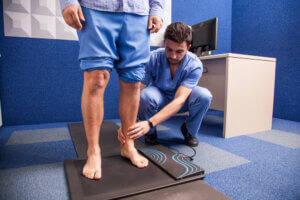Time to challenge our understanding of pronation
At ConsultingFootPain my colleagues and I try to take the mystique out of foot health science and recognise it is easy to confuse patients. For example, pronation is a word related to anatomical movement. YouTube videos are included in this article
Sports magazines and journals, podiatrists and others use the word pronation all the time. However, do we know or understand the importance of the term, which can be used to confuse? In addition, the word is often associated with flat feet.
Is pronation another word for flat foot?
Flat foot is NOT the same as pronation, just as a flat foot does not mean your foot is abnormal – Time to challenge flat foot.
Prone-pronation: an explanation
Lie on your tummy and moving position from lying on your back to your tummy is called ‘pronation’; you are now prone. Flip back and you become supine. Take your hand. Palm down – it is prone, back up and you will supinate your hand at the wrist.
The foot does not move as the hand because a foot shares intimate contact against the ground. If we twist our leg over the foot when standing so that the knee (knee cap) faces inwards, it rolls inwards – this is when the foot pronates. Rotate the knee when standing on the ground back the other way and the arch rises – the foot has supinated. The image below shows a podiatrist placing the foot in between pronation and supination. Check out this 28 sec YouTube video
By now you might think – so what!
“You over-pronate Mrs Johnson, you need orthotics.”
I am not saying podiatrists use these words, but such a phrase can creep into a conversation with anyone who sells orthoses – the formal arch support. The first warning is caution when a non-professional tries to sell you formal orthoses after watching you walk or placing you on a pressure mat. Once they start with the words, pronate and make it the subject of concern – walk away – unless you fit the criteria below. Always consult a health professional, ideally a foot specialist called a podiatrist. Podiatrists are regulated and must ensure standards are met and safeguard patients.
Let’s challenge
Here are some facts – pronation is vital for normal foot function. This second YouTube video is 31 secs long but talks about overpronation and under pronation. It sounds, from the video, that overpronation is wrong but this is not the case but shows the extremes.
Normal v abnormal
We all know that we are different to each other. And so each foot is different.
We have different lifestyles, we are active, not active we might be dedicated health fanatics taking loads of exercise regularly. When we walk, some have low, some have higher arches. If the toes are flat, that is, don’t bend then this is normal although there might be a slight bend. We might have no pain when walking any distance; in this case your foot is probably doing what it is designed to do. If your shoe wear does not need replacing that often, the foot is probably working well enough. My shoewear patterns allow me to keep shoes for 2-3 years without any concern for deterioration – but then I drive and use walking boots designed for longer treks. If you walk more, you may need to renew your regular shoes more often.
Basic mechanics of pronation
Pronation is normal because we need to cushion our contact with the ground. Some 25% of that contact is shock absorption, but up to 50% of the contact is pronating to achieve this mechanical process. As we speed up (again, see video 2), the foot position looks more alarming the way it leans in. Each foot spends time in the air while the opposite foot takes the weight. As we speed up, the time of contact in the air increases and the time in contact is shortened. A slow walker, a disabled or injured person spends longer in contact. The forces from contact decrease until we walk faster or start to run. These continuous changes in walking patterns are known as the GAIT CYCLE.
For those who want more technical details try out this link – orthobullets
We have powerful muscles in the leg which run tendons around the ankle, acting as tent guy ropes. The most powerful tendon group is the calf muscle (gastrocnemius and soleus). The side tendons are important and come off the leg (tibia), so they are called the tibialis tendons. The front tendon (anterior) and the back tendon (posterior) work in harmony but can fail and become strained. This forms a condition known as tendinitis and sometimes shin splints.
Overpronation, especially in active people, may benefit from orthoses that can help ease the strain by affecting the dynamic over-pull on tendons.
In summary
- Pronation is expected and essential for shock absorption
- We over-pronate more when active at a speed
- You don’t need treatment unless your tendons become painful on movement
- Toes that bend or have corns on the top and shoes that have to be replaced frequently are indicators worthy of a consultation with a podiatrist
Thanks for reading this short article “Selling and misselling orthoses” by David R Tollafield
If you have enjoyed this brief article there are more articles on the same subject on this site. Time to challenge the flat foot is part of my foot health myths series. Shin splints and tendon dysfunction will provide more information on tendon control. David is a registered podiatrist, author and journalist
Sign-up for here my regular FREE newsfeed
Published by Busypencilcase Communications. Est. 2015 for ConsultingFootPain




Recent Comments